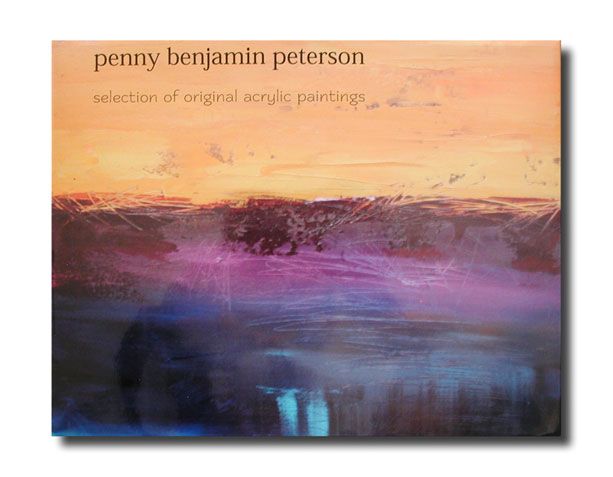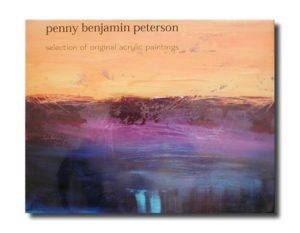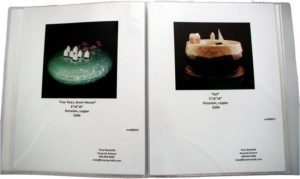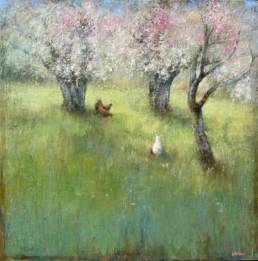As an artist, the portfolio is your primary tool in getting your work in front of potential collectors and gallery owners. The art portfolio is going to be the first impression you leave, and you want to leave the right impression so you can find the right gallery.
After photographing your artwork, there are three primary concerns in creating a portfolio are:
- format
- content
- convenience
You want to present your artwork in a way that is easily accessible to the gallery owner – forethought and simple design will allow you to do this effectively.
You now have a selection of different portfolio formats. Twenty-five years ago, an artist’s portfolio was exactly that: a large portfolio with photos slipped into plastic sheets.
Now you can choose between many different formats:
- including Image CDs
- hard or soft-cover books printed online,
- purely digital .pdf portfolios, etc.
Each of these formats has something to offer, and each comes with drawbacks.
The CD :
The CD is filled with digital images of your work is an inexpensive way to get a number of your portfolios out there. You can burn dozens of CDs for just a few dollars, and they are inexpensive to mail. The drawback to the CD is that it is easy for me to throw away, without ever having looked at the images; and the truth is, I do this all the time. Looking at a CD is simply too much work for me in my busy life. I have to get it into the computer, close whatever else I was working on, only to discover that you created the images on a Mac, while I am on a PC, so my computer doesn’t want to open them. It’s honestly more effort than I care to expend.
That’s not to say you shouldn’t create CDs of your work; they truly can be great ways to multiply your efforts and get your work out to a larger audience. However, I recommend you use the CD as a supplement to your primary portfolio, and not as the primary portfolio itself.
The Digital Photo Book:
You can now print on-line inexpensively (visit sites like Blurb.com, or mypublisher.com to see examples) and professionally, is another option to consider. This book reproduces your work beautifully, and looks like it just came out of a bookstore. Nothing will stroke your vanity like seeing your work in print in one of these books.
The problem? Unless you are willing to republish and reformat your book every month or so, it is quickly going to be out of date. This would be another great supplementary item for you to sell at art festivals, but is not flexible enough to be your primary portfolio.
The Presentation Folder:
The disposable presentation folder, a simple report cover with 20-30 plastic sheet holders inside is my favorite portfolio. You will find them at your local office supply store, and can use them to create a half-dozen identical portfolios. Print the images from your high-quality home inkjet, and insert the pages into the folder. You now have an easy-to-maintain, professional portfolio that will enable you to get your most recent images in front of your target audience.
Each portfolio page should include 1-2 images. With each image, you should include all pertinent information: title, medium, size, and price. Make it easy for me to know exactly what I am looking at.
I recommend you format your portfolio to make the images what the viewer sees first. Include 20-25 images in the portfolio, including several sold pieces, clearly marked as sold (or even better, show them in the settings of the owners’ homes or offices). Place your bio, resume and artist’s statement at the back of the portfolio.
A powerful portfolio will open doors for you to be able to share your work with collectors through galleries. Ensure you have invested the time and effort to present potential galleries with a strong portfolio.
*****
Guest author: Jason Horejs is a Scottsdale, Arizona gallery owner of Xanadu Gallery. Jason is also and art business advisor. For more information: Visit http://www.xanadugallery.com/Portfolio/FreePtfWksRegister.asp to watch a free 25 minute presentation on building a portfolio. To learn more about every aspect of organizing your work and getting into galleries, read Jason’s recently released book, “Starving” to Successful – The Artist’s Guide to Getting into Galleries and Selling More Art.
Jason, thanks for the great article! Lori 🙂
*****
I hope you will enjoy the following articles:
Learn the Two Biggest Mistakes Artists Make with Social Media
5 Reasons Why Artists Need Social Media & Eye Opening Stats to Back it Up!
Top Paint Brush Tips from the Pros on Facebook
Newsletter Art Marketing Tips that Work!
7 Ways to Get Motivated in the Studio to Sell More Art
5 Common Traits of Successful Artists
Finding Your Own Artistic Voice












Great information. Thanks!
This is great info and a really interesting perspective from a gallery owner. In my experience, though, most galleries are shifting towards digital submissions rather than photos. I understand that photos are more immediate and convenient to view, but I’ve never encountered a gallery that wanted them. Most ask for digital images or slides at the least. A few have even asked for the entire proposal to be in PDF form on a CD to eliminate paper altogether. It all depends on the gallery!
You’re right. It is individual preference… thanks for sharing your experiences with us. I hope all of this advice helps others in making the right choice of choosing a portfolio format. Take care, Lori
Great advice! Thanks for sharing.
Glad to share some good advice from a gallery owner! Hope it helps you…Lori 🙂
Hello, nice blog post! I have been using the Artists Portfolio Creator software (http://www.artists-portfolio-creator.com/) for a while to create CD portfolios for my submissions to galleries and it works great. It can also make PDF portfolios so you can print them out or email if you need to which makes it quite versatile. Worth checking out if you haven’t already 🙂
Thanks for sharing your experience with Artists Portfolio Creator software. I will pass this information on! Best- Lori
Hello from Russia!
Can I quote a post in your blog with the link to you?
This is the MOST important part of being an artist- it sells work and gets you in galleries. Thank you for sharing what you have learned about representing your art. This story is a beautiful gift.
Hello Ann Marie, your sweet comment is very much appreciated. I really am so happy my articles are helpful to others.
Best-
Lori
Thanks for the tips – I’m a beginner in presenting my work The tips wil help met to present myself.
Hello Joan, I’m so glad you found this post useful. 🙂
Hi Lori,
I want to create a small (8.5 x 11) portfolio. I had a photographer friend photograph the paintings. What is the best size of photograph to have on an 8.5×11 sheet of paper? Also, should the picture of the painting be “framed” in? If so, is black or grey a good option? If the picture is “framed” in using a white background do you print it on a colored sheet of paper?
Can you tell I’m new to this?!!:) Thanks for the help. I love your art work and website!
Hello Laurie,
The camera will keep a similar proportion to your 8.5×11 size. You can make the size on your computer once you upload the image. I prefer a white boarder unless you are bleeding the image to the edge. I hope this helps. Good luck.
Great Article! It is also worth to mention that creating an online web portfolio is very important to gain presence in the global art market. Sites like http://photeria.net make it very easy to set up a professional look and great experience even without any technical knowledge.
Thanks to my online portfolio I am getting more customers now than from any other source. Important thing is to have clean and simple design with professional domain name and interesting art to show. Don’t miss this!
I haven’t heard of that site before. Thanks so much for sharing the link with us here. I’ll check into it! ~Lori